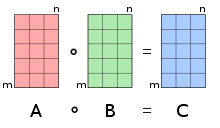在数学 中,阿达玛乘积 (英语:Hadamard product ,又译哈达玛乘积 ),又名舒尔乘积 (Schur product )[ 1] 逐项乘积 (entrywise product )[ 2] :ch. 5 ,是一个二元运算 ,其输入为两个相同形状的矩阵 ,输出是具有同样形状的、各个位置的元素等于两个输入矩阵相同位置元素的乘积的矩阵。此乘积归功于法国数学家雅克·阿达马 或德国数学家伊赛·舒尔
作用在两个相同形状的矩阵上的阿达玛乘积,结果是第三个相同形状的矩阵。 “
逐项积 ”重定向至此。关于函数的逐点乘积,请见“
逐点乘积 ”。
阿达玛乘积满足交换律 (当其元素属于交换环时), 结合律 和对加法的分配律 :
A
∘
B
=
B
∘
A
,
A
∘
(
B
∘
C
)
=
(
A
∘
B
)
∘
C
,
A
∘
(
B
+
C
)
=
A
∘
B
+
A
∘
C
.
{\displaystyle {\begin{aligned}&\mathbf {A} \circ \mathbf {B} =\mathbf {B} \circ \mathbf {A} ,\\&\mathbf {A} \circ (\mathbf {B} \circ \mathbf {C} )=(\mathbf {A} \circ \mathbf {B} )\circ \mathbf {C} ,\\&\mathbf {A} \circ (\mathbf {B} +\mathbf {C} )=\mathbf {A} \circ \mathbf {B} +\mathbf {A} \circ \mathbf {C} .\end{aligned}}}
在阿达玛乘积意义下,m × n 单位元 是全部元素均为1的m × n 。这跟普通矩阵乘法的单位元 只有主对角线上的元素为1的单位矩阵 不同。此外,当且仅当没有任何元素等于 0 时,矩阵的阿达玛乘积有逆矩阵。[ 3]
对于向量x y D x D y [ 2] :479
x
∗
(
A
∘
B
)
y
=
tr
(
D
x
∗
A
D
y
B
T
)
,
{\displaystyle \mathbf {x} ^{*}({A}\circ {B})\mathbf {y} =\operatorname {tr} \left({D}_{\mathbf {x} }^{*}{A}{D}_{\mathbf {y} }{B}^{\mathsf {T}}\right),}
x * x 共轭转置 。特别的,使用全1向量,可以发现阿达玛乘积的所有元素求和是AB T 矩阵转置 )的迹 。对于方阵 A B AB T [ 4]
∑
i
(
A
∘
B
)
i
j
=
(
B
T
A
)
j
j
=
(
A
B
T
)
i
i
.
{\displaystyle \sum _{i}(A\circ B)_{ij}=\left(B^{\mathsf {T}}A\right)_{jj}=\left(AB^{\mathsf {T}}\right)_{ii}.}
(
y
x
∗
)
∘
A
=
D
y
A
D
x
∗
{\displaystyle \left(\mathbf {y} \mathbf {x} ^{*}\right)\circ {A}={D}_{\mathbf {y} }{A}{D}_{\mathbf {x} }^{*}}
(
A
∘
B
)
y
=
diag
(
A
D
y
B
T
)
{\displaystyle (A\circ B)\mathbf {y} =\operatorname {diag} \left(AD_{\mathbf {y} }B^{\mathsf {T}}\right)}
diag
(
M
)
{\displaystyle \operatorname {diag} (M)}
M
阿达玛乘积是克罗内克乘积 的主要子矩阵 。
阿达玛乘积满足秩不等式
rank
(
A
∘
B
)
≤
rank
(
A
)
rank
(
B
)
{\displaystyle \operatorname {rank} ({A}\circ {B})\leq \operatorname {rank} ({A})\operatorname {rank} ({B})}
如果A B 正定矩阵 ,那么下列不等式成立:[ 5]
∏
i
=
k
n
λ
i
(
A
∘
B
)
≥
∏
i
=
k
n
λ
i
(
A
B
)
,
k
=
1
,
…
,
n
,
{\displaystyle \prod _{i=k}^{n}\lambda _{i}({A}\circ {B})\geq \prod _{i=k}^{n}\lambda _{i}({A}{B}),\quad k=1,\ldots ,n,}
λi (A )A i 特征值 。
如果D E 对角矩阵 ,那么[ 6]
D
(
A
∘
B
)
E
=
(
D
A
E
)
∘
B
=
(
D
A
)
∘
(
B
E
)
=
(
A
E
)
∘
(
D
B
)
=
A
∘
(
D
B
E
)
.
{\displaystyle {\begin{aligned}{D}({A}\circ {B}){E}&=({D}{A}{E})\circ {B}=({D}{A})\circ ({B}{E})\\&=({A}{E})\circ ({D}{B})={A}\circ ({D}{B}{E}).\end{aligned}}}
两个向量
a
{\displaystyle \mathbf {a} }
b
{\displaystyle \mathbf {b} }
对角矩阵 做矩阵乘法得到的结果相同:
a
∘
b
=
D
a
b
=
D
b
a
{\displaystyle \mathbf {a} \circ \mathbf {b} =D_{\mathbf {a} }\mathbf {b} =D_{\mathbf {b} }\mathbf {a} }
将向量映射到对角矩阵的
diag
{\displaystyle \operatorname {diag} }
diag
(
a
)
=
(
a
1
T
)
∘
I
{\displaystyle \operatorname {diag} (\mathbf {a} )=(\mathbf {a} \mathbf {1} ^{T})\circ I}
1
{\displaystyle \mathbf {1} }
全
1
{\displaystyle 1}
,
I
{\displaystyle I}
单位矩阵 。
^ Davis, Chandler. The norm of the Schur product operation. Numerische Mathematik. 1962, 4 (1): 343–44. doi:10.1007/bf01386329 ^ 2.0 2.1 Horn, Roger A.; Johnson, Charles R. Matrix analysis. Cambridge University Press. 2012. ^ Million, Elizabeth. The Hadamard Product (PDF) . [2 January 2012] . (原始内容 (PDF) 存档于2013-06-12). ^ Styan, George P. H., Hadamard Products and Multivariate Statistical Analysis, Linear Algebra and Its Applications, 1973, 6 : 217–240, doi:10.1016/0024-3795(73)90023-2 hdl:10338.dmlcz/102190 ^ Hiai, Fumio; Lin, Minghua. On an eigenvalue inequality involving the Hadamard product. Linear Algebra and Its Applications. February 2017, 515 : 313–320. doi:10.1016/j.laa.2016.11.017 ^ Project (PDF) . buzzard.ups.edu. 2007 [2019-12-18 ] . (原始内容 (PDF) 存档于2013-06-12).
